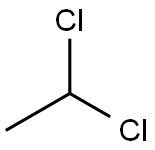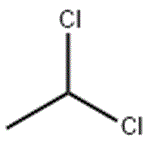Chlorinated aliphatics as a class are known to cause central
nervous system (CNS) depression and respiratory tract and
dermal irritation when humans are exposed by inhalation to
sufficiently high concentrations. In the past, 1,1-dichloroethane
was used as an anesthetic; however, this use was discontinued
due to the risk of induction of cardiac arrhythmia in humans.
Crystal precipitations and obstruction in the renal tubule lumina
and increases in serum urea and creatinine were observed in cats
exposed to this compound for weeks. However, these effects were
not observed in rats, guinea pigs, or rabbits. However, kidney
effectswere observed inmice administered a lethal intraperitoneal
injection; the effects included increased glucose and protein in the
urine and tubular swelling. The toxicological significance of the
nephrotoxicity observed in cats and the mice with regard to
human health is not known given the small number of animals
tested (cats).The detectionof 1,1-dichoroethane or itsmetabolites
in blood and urine cannot predict the type of health effects that
might develop from that exposure; because 1,1-dichloroethane
and its metabolites leave the body fairly rapidly, the tests need
to be conducted within hours to days after exposure.



